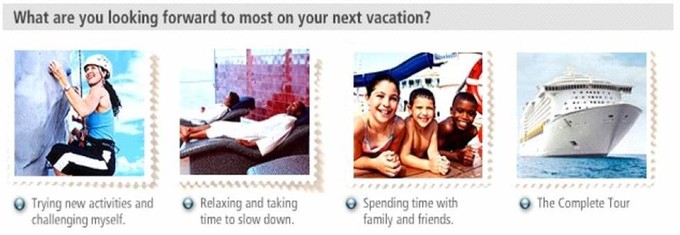Virtually Being There
Royal Caribbean Cruises, Ltd. Creates an Online Onboard Experience
Providing an engaging customer experience is the goal of all savvy businesses. But how do you give a preview of an interactive vacation activity that really captures the essence of the experience? Royal Caribbean Cruise Ltd. has developed an interactive Web site for its Freedom of the Seas ship. In an interview with Maria Polo Gonzalez, manager of e-marketing and distribution for the cruise line, she describes how she and her team brought the onboard experience online.
Background: Web Site Re-Design to Introduce New Ship--Freedom of the Seas
In 2006, Royal Caribbean Cruises, Ltd. (RCCL) launched its newest ship, Freedom of the Seas, which made its maiden voyage from Miami on June 4th, 2006. Even though the cruise line has introduced new ships many times, RCCL took the launch of Freedom of the Seas as an opportunity to create a different type of Web experience for potential customers. This online experience, www.freedomoftheseas.com, uses online multimedia to showcase the amenities and activities of the new ship and to give a real feel for what it is like on board.
How Royal Caribbean Cruises Created an Online Onboard Customer Experience
Q&A with Maria Polo Gonzalez, Manager of E-Marketing and Distribution
PATRICIA SEYBOLD GROUP (PSG). What was the impetus for the redesign of the Web site for Freedom of the Seas?
MARIA POLO GONZALEZ. When RCCL began to market Freedom of the Seas, the ship was under construction in Finland. So we didn’t have much to show to consumers, to our partners, or to the media. In the past, we used press releases and pictures of existing ships to promote new ships. We also relied heavily on an inaugural event. We would have a two- to three-week inaugural period to introduce the ship to customers and the trade before revenue cruises started. But, for Freedom of the Seas, we wanted to move the booking window earlier.
So, to make sure the ship would be booked for its first voyages, we had to start selling a year and a half before Freedom of the Seas would actually set sail.
This was the impetus for creating a brand new Web site specifically for Freedom of the Seas--to create awareness with trade partners and consumers about our new ship that was about to debut.
Our goal was to use audio and visual elements to actually “place” the consumer on board the ship and to let partners use the site to show their customers just what the Freedom of the Seas experience would be like.
PSG. What are your target customer segments, and what experience did you want to provide them?
MARIA POLO GONZALEZ. Our two primary customer segments are partners (travel agencies) and consumers (cruise passengers). We break consumers down into different segments with different mindsets about vacations. Our target is what is called the “explorer” mindset. This is the type of vacationer who likes to try new things, but isn’t into extreme activities--that’s a different mindset. Typical segments include families, young adult, adventure, and relaxation. We’re looking for the explorer mindset within these segments.
The whole Freedom of the Seas brand experience promotes that, on board the ship, you’ll find a lot of new things to try that you don’t normally find in your day-to-day life. Our ships, in general, include activities not found on other cruise lines, like miniature golf, ice skating rinks, rock climbing walls, and, on Freedom of the Seas, a surfing simulator called the FlowRider®.
We wanted to create a new way of introducing an onboard experience, both for potential passengers and for our partners to use to differentiate Freedom of the Seas and RCCL for their customers.
PSG. What kinds of research did you do on what each customer segment wanted for their cruising experience?
MARIA POLO GONZALEZ. We started by having our agency of record, Arnold Worldwide, located in Boston, identify the attributes of the explorer mindset. Then, basically, we divided our target consumers with the right mindset into two groups: people who have never cruised before and those who have cruised, but not exclusively on our line. We conducted offline surveys, focus groups, and interviewed passengers while they were on board our ships.
For the novices, we talked to them about why they haven’t taken a cruise. We discovered that there are a lot of misconceptions about cruising. People were worried that they would be confined to the ship with nothing to do but eat and sit by the pool.
The people who had cruised before on other lines--they hadn’t experienced our brand--said, “Show me how different you are from everything out there.”
PSG. How different were the desires and expectations for the different segments?
MARIA POLO GONZALEZ. People wanted all sorts of different types of activities. However, everyone wanted a unique vacation. Another big concern was that they wouldn’t find other people on board with similar interests. So it was important to show an environment that was tailored for each segment, and to show that, while onboard, you’d find people like you and things you like to do. For example, families are looking for kid activities; couples want to know about nighttime activities and entertainment and to see how the stateroom would look; people looking for relaxation wanted to know about the spa and pool, etc. (See Illustration.)
Tailoring the Online Experience by Segment

When you first enter the interactive freedomoftheseas.com site, you get to choose what type of activities you want to see based on your interests. This self-segmentation wasn’t part of the original site launch, but was added later to personalize the experience. “Wendy,” your tour guide, was also added after several months.
Sign in to download the full article
0 comments
Be the first one to comment.



